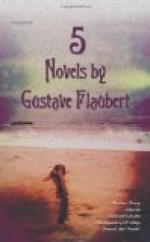|
This section contains 5,056 words (approx. 17 pages at 300 words per page) |

|
SOURCE: Mossman, Carol A. “Salammbô: Seeing the Moon through the Veil.” Neophilologus 73, no. 1 (January 1989): 36-45.
In the following essay, Mossman assesses Salammbô as an iconoclastic juxtaposition of myth and history illuminated by a symbolic conjunction of the sacred and the feminine.
Beyond the literary violence which is Salammbô—with its gruesome details of desert war waged between the Mercenaries and the Carthaginians and the cannibalism to which the Mercenaries are ultimately reduced, with the periodic, painfully clinical descriptions of Hanno's advancing leprosy—lies a tale of profanation. Flaubert's novel in fact begins by defiling the sacred as the drunken Barbarians, for sport, slaughter Salammbô's holy fish, direct descendants of Carthage's piscine ur-mothers which “avaient fait éclore l'oeuf mystique où se cachait la Déesse” (35). This preliminary assault poses an important paradigm, constituting as it does an act of violence directed against maternal origins.
What follows in Salammb...
|
This section contains 5,056 words (approx. 17 pages at 300 words per page) |

|


